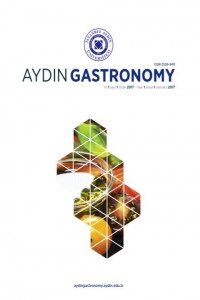Abstract
Ekşi hamurdan ekmek üretimi mayadan ekmek üretimi yaygın olamamakla birlikte Anadolu’da halen sürdürülmektedir. Çok sayıda mikroorganizmanın rol oynadığı bu teknik ile üretilen ekmeklerin maya ile üretilen ekmeklere göre üstün özellikleri vardır. Bu çalışma farklı yöntemlerde ekşitilmiş hamurdan üretilecek ekmekleri belli özellikleri yönünden karşılaştırmak amacıyla gerçekleştirilmiştir. Bu amaçla yoğurt ile (A), boza ile (B) ve geleneksel (C) olmak üzere üç ayrı ekşi hamur elde edilmiş; bunlardan tam buğday unu kullanılarak üç farklı ekmek yapılmıştır. Ekmekler duyusal ve teknolojik özellikleri bakımından analiz edilmiştir. A grubu ekmekler incelenen bütün duyusal kriterler (kabuk rengi, ekmek içi rengi, doku, koku, tat, kıvam) bakımından en yüksek puanları almıştır. B grubu ekmekler ise doku hariç en düşük puanlara sahip olmuştur. Pişme sırasında en fazla kabarma A grubunda, en yüksek pişme kaybı A gurubunda, en yüksek asitlik değeri B grubunda, muhafaza sırasında en fazla nem kaybı B grubunda saptanmıştır. Dokuz günlük muhafazanın sonunda A ve C grubu ekmeklerde küf sayısı sırasıyla 2,48 ve 3,30 log kob/g iken boza ile yapılan B grubunda ise sayılabilir düzeyde küf gelişimi olmamıştır. Elde edilen bulgulara göre yoğurt kültürü ile ekşitilen hamurlardan yapılan ekmeklerin duyusal ve fiziksel özellikleri bakımından diğerlerine üstün olduğu sonucuna varılmıştır
Keywords
Abstract
Sour dough bread production is maintained in Anatolia.although it is not be common. Breads made by this technique that numerous microorganisms play a role, have many outstanding compared with bread made with yeast. This study was carried to compare the breads produced with sour obtained in different ways in terms of certain features. For this purpose, three different sour dough (A: by yoghurt addition; B: by boza addition; C: conventional) was obtained. Three group breads were produced using whole wheat flour with these sour dough. Breads were analysed in terms of sensorial, technological properties A group has received the highest scores of sensory criteria (skin color, crumb color, texture, smell, taste, consistency). Group B has had the lowest score except texture. The most swelling during baking and the highest cooking loss ratio (13,2%) were determined in group A. The highest moisture loss during storage and the highest levels of acidity (0.51%) was found in group B. At the end of the nine-day storage, it was not determined mould growth on countable level in group B while mould counts in A and C groups were 2.48 and 3.30 log cfu/g, respectivelly. According to the results obtained, it was concluded that sensory and physical properties of bread made from sour dough with yogurt cultures are superior to others
Details
| Other ID | JA89KA57HF |
|---|---|
| Journal Section | Research Article |
| Authors | |
| Publication Date | January 1, 2017 |
| Published in Issue | Year 2017 Volume: 1 Issue: 1 |


